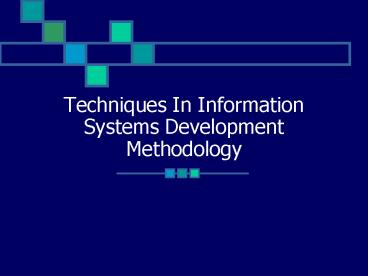Techniques In Information Systems Development Methodology - PowerPoint PPT Presentation
1 / 19
Title:
Techniques In Information Systems Development Methodology
Description:
Techniques In Information Systems Development Methodology Kinds of Techniques Rich Pictures Root Definitions Conceptual Models Entity Modeling Normalization Data Flow ... – PowerPoint PPT presentation
Number of Views:180
Avg rating:3.0/5.0
Title: Techniques In Information Systems Development Methodology
1
Techniques In Information Systems Development
Methodology
2
Kinds of Techniques
- Rich Pictures
- Root Definitions
- Conceptual Models
- Entity Modeling
- Normalization
- Data Flow Diagram
- Decision Trees
- Decision Tables
- Structured English
- Action Diagrams
- Entity Life Cycle
- Object Orientation
- Structure Diagrams
- Matrices
3
A Classification of Techniques
Stage Overall Data Processes
Strategy Rich pictures
Analysis Rich pictures,Objects, Matrices, Structure diagrams Entity Modeling DFD, Entity life cycle, Process logic, Root definitions, Conceptual models
Logical Design Objects, Matrices, Structure Diagrams Normalization Process logic
Program/Database Design Objects, Matrices, Structure Diagrams Normalization Process logic
4
Rich Pictures
- Help to understand the problem situation in
general at beginning of a project - It is a pictorial caricature of an organization
- It is a tool for helping to explain what the
organization is about - It helps people to visualize and discuss their
roles - It can show the worries of individuals, potential
conflict, and political issues - Etc.
5
Root Definitions
- Can be used to define two things that are
otherwise both vague and difficult problems and
systems - A concise verbal description of the system which
captures its essential nature - Who is doing what for whom, and to whom are they
answerable, what assumptions are being made, and
in what environment is this happening? - C(lient) A(ctor) T(ransformation) W(eltanschuung)
O(wner) E(nvironment) CATWOE - A system owned and operated by the professional
association to administer the examinations by
registering , supervising, recording and
notifying students
6
Conceptual Models
- It is an essential element in the architects
design activities - It is a medium of communication between
architects and clients to enable the right design
to be selected - It is a set of instructions to the builders
7
Entity Modeling
- Define the area for analysis
- Define the entities and the relationships between
them - Establishing the key attributes for each entity
- Complete each entity with all the attributes
- Normalize all the entities
- Ensure all events and operations are supported by
the model
8
Normalization
- It is a process of transforming data into well
formed or natural groupings such that one fact is
in one place and that the correct relationships
between facts exist
9
Data Flow Diagram
- Provides the key means of achieving one of
structured systems - Provides the analyst with the ability to specify
a system at the logical level - Represents logical information, not the physical
aspects
10
Decision Trees
- To facilitate the documentation of process logic,
particularly where there are many decision
alternatives - Decision trees are constructed by first
identifying the conditions, actions
11
Decision Tables
- Appropriate where there is a large number of
actions as they can be decomposed into sets
conveniently
12
Structured English
- It is a precise way of specifying a process, an
is readily understandable by a trained systems
designer as well as being readily converted to a
computer program - Sequencing
- Selection
- Repetition
- Case
13
Action Diagrams
- Support the structured programming constructs of
condition, case, repetition, reapeat.until
Admit a student Review application Interview
student Make decision Communicate decision
Function admit a student
14
Entity Life Cycle
- It is used at a variety of stages in a number of
methodologies and is one of the few attempts to
address changes that happen over time - The diagram provides a pictorial way of
communication that enables users to validate the
accuracy or otherwise of the analysis
15
End state
Start state
Event
Same state
Entity state
Process
16
Object Orientation
- An object is something to which actions are
directed, it has an identity, a state, and
exhibits behavior
17
Structure Diagrams
- Representing processes or parts of computer
programs (modules) and connecting lines - Each module should be small and manageable
18
A
D
G
F
E
B
C
Module A can call module B and also module C When
A calls B, it sends data of type D to B, when B
terminates, it returns data of type E to A. Its
variation Warnier-Orr diagram
19
Matrices
Function Event Process enquiry Selection Enrolment Accounts
Student Enquiry X X
Student Accepted X X
Student registers X































